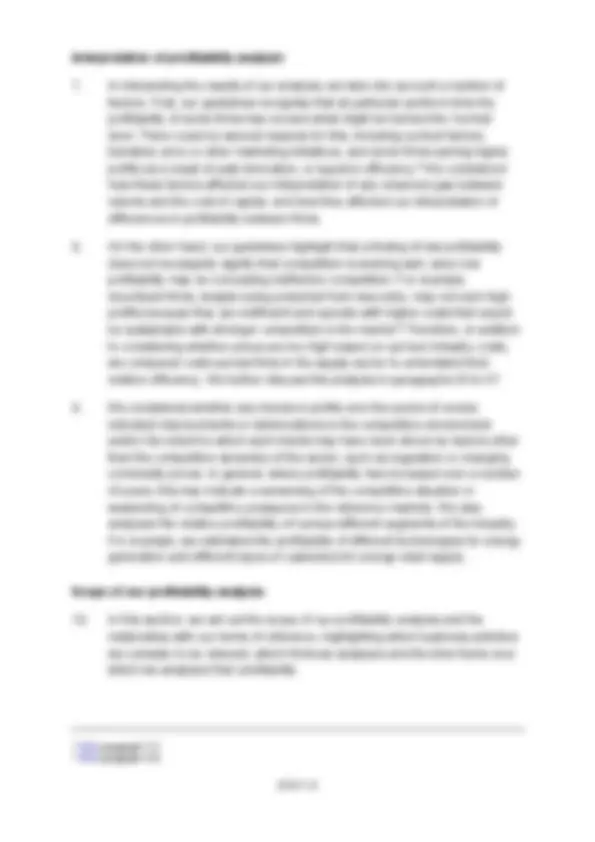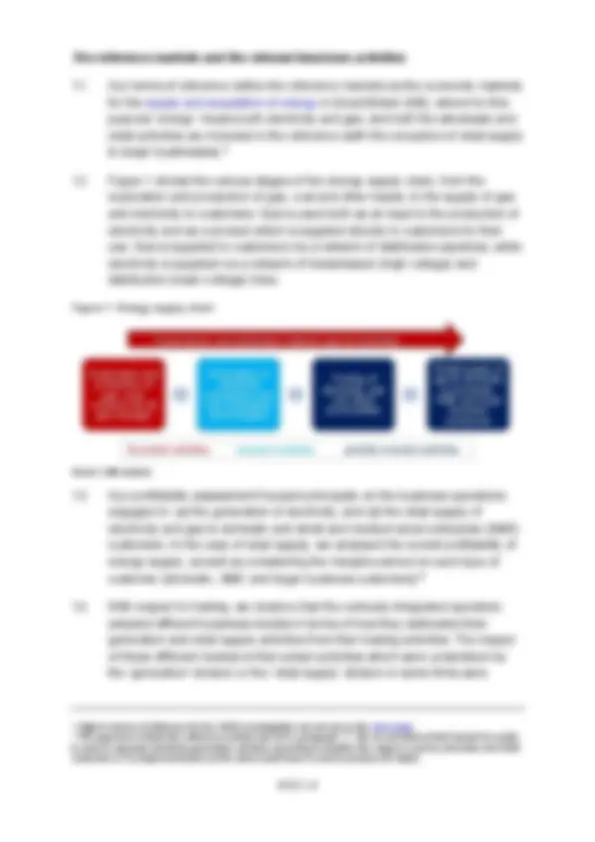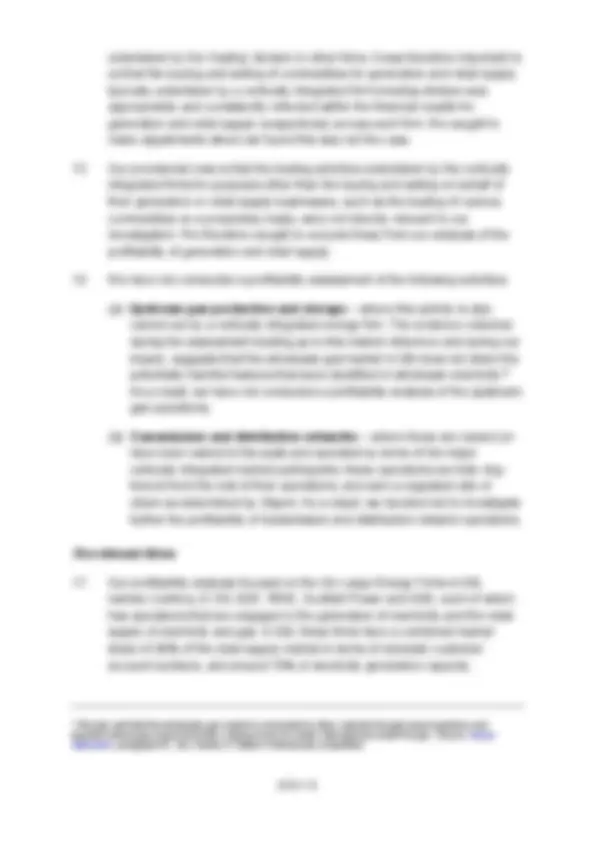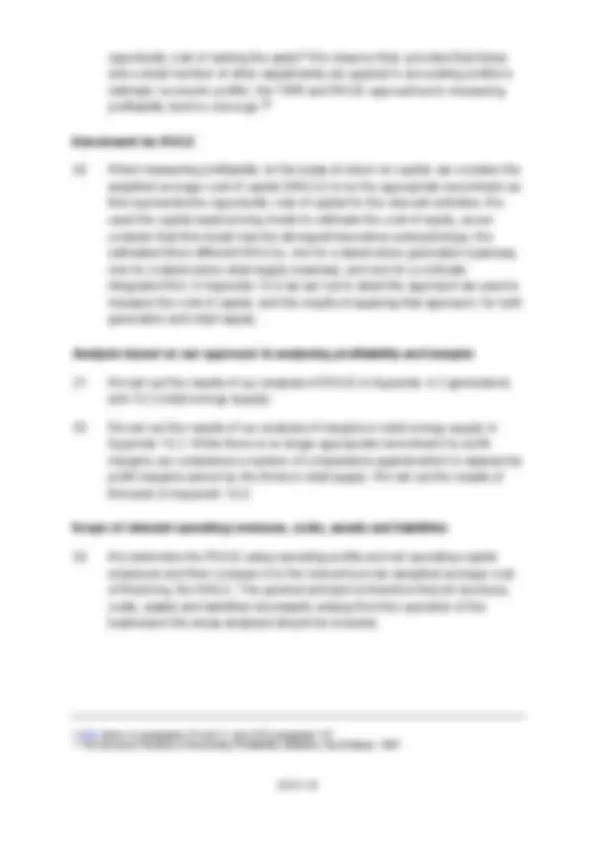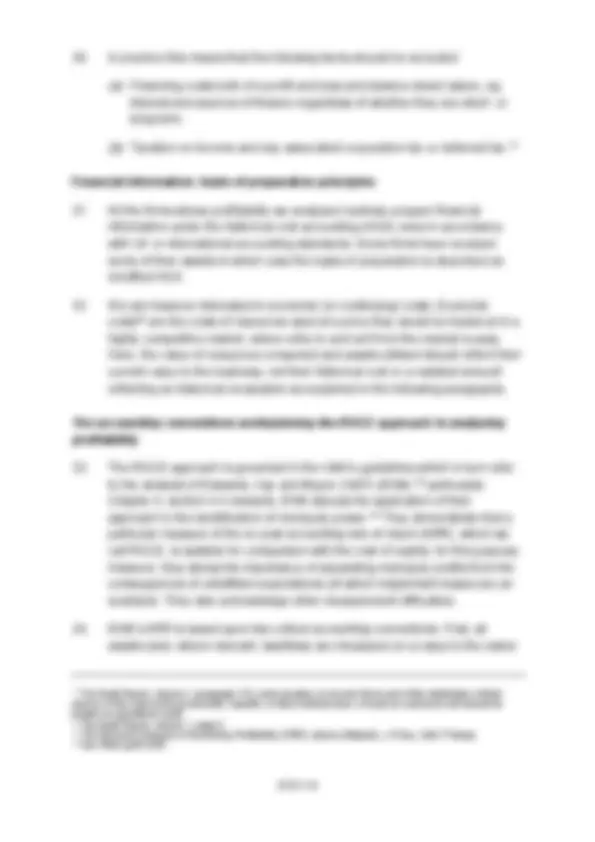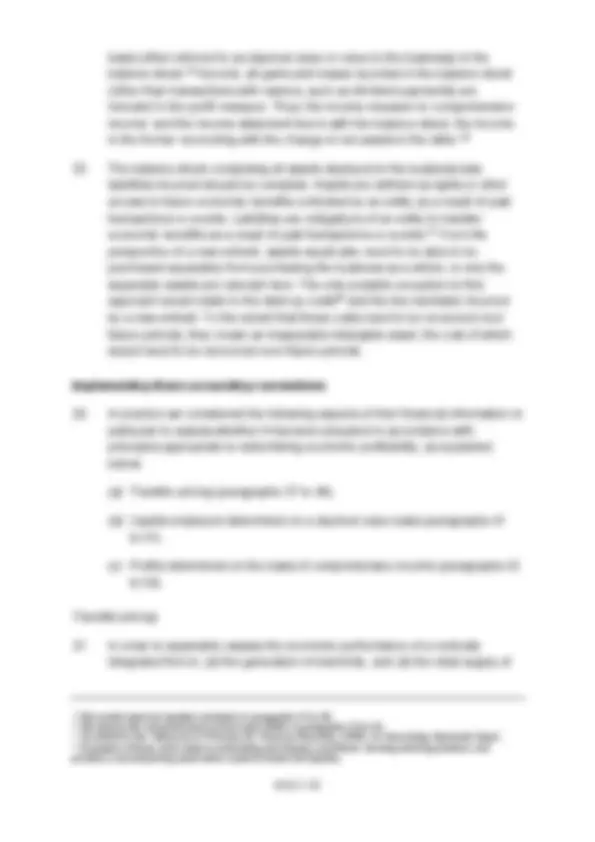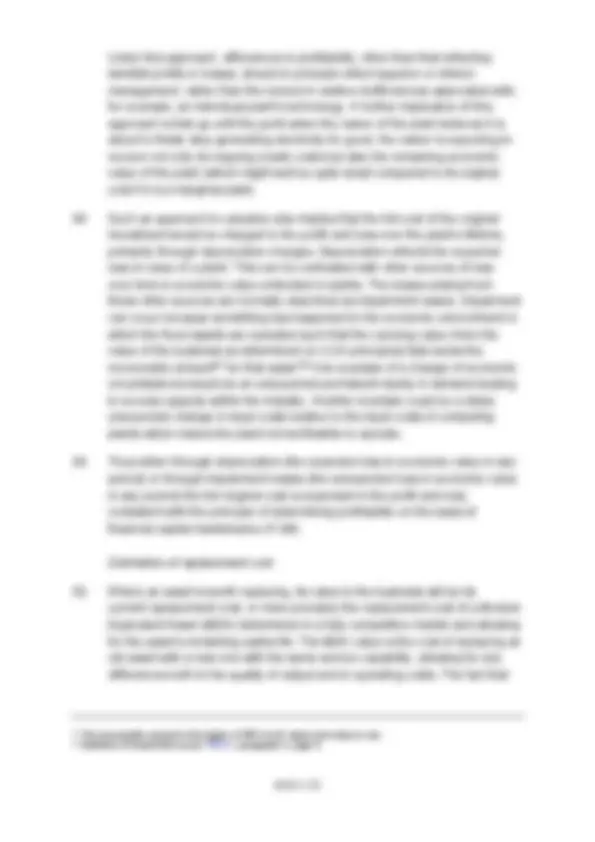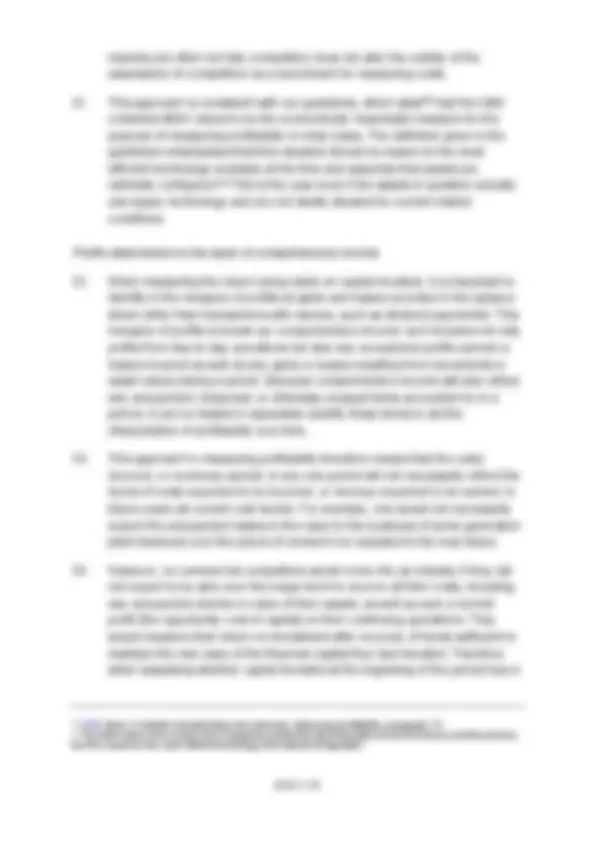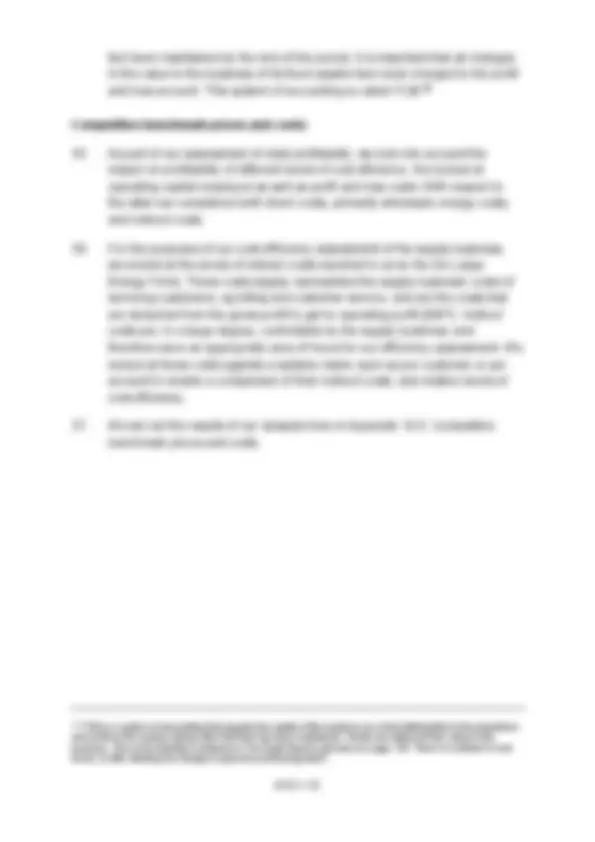Download Energy Retail Supply: ROCE Analysis and Price/Cost Benchmarking and more Lecture notes Business Economics in PDF only on Docsity!
Appendix 10.1: Approach to profitability and financial analysis
Contents Page
Introduction ................................................................................................................ 1
Purpose and interpretation of profitability analysis ..................................................... 2
Scope of our profitability analysis ............................................................................... 3
Selection of profitability measure and associated benchmark .................................... 7 Scope of relevant operating revenues, costs, assets and liabilities ............................ 8
Financial information: basis of preparation principles ................................................. 9
Competitive benchmark prices and costs ................................................................. 15
Introduction
- In this appendix we set out our approach to analysing profitability in this market investigation. We explain why we have undertaken this analysis and the generic approach adopted across the elements of the energy sector value chain we have analysed. The results of our analysis are set out in detail in the following appendices:
(a) Cost of capital (Appendix 10.4);
(b) Generation return on capital employed (Appendix 4.2);
(c) Retail energy supply profit margin analysis (Appendix 10.2);
(d) Retail profit margin comparators (Appendix 10.6);
(e) Analysis of retail supply profitability (Appendix 10.3); and
(f) Assessment of the competitive benchmark in energy retail supply (Appendix 10.5).
- Most elements of our approach for analysing profitability, for example our chosen measure of profitability and the overarching approach to valuing a firm’s asset base, are common across the energy supply value chain and are set out in this appendix. However, where we have implemented our approach in a way specific to an individual piece of analysis, then we set out the detail of that implementation in the relevant appendix.
- We supplemented our profitability analyses by conducting analysis of retail energy supply profit margins, considering the relevance of margin
benchmarks for retail energy supply and analysing the efficiency of the costs incurred by firms in retail energy supply.
- The rest of this appendix is structured as follows:
(a) Purpose and interpretation of profitability analysis (paragraphs 5 to 9 ).
(b) Scope of our profitability analysis (paragraphs 10 to 22 ).
(c) Selection of profitability measure and associated benchmark (paragraphs 23 to 28 ).
(d) Scope of relevant operating revenues, costs, assets and liabilities (paragraphs 29 to 30 ).
(e) Financial information: basis of preparation principles (paragraphs 31 to 54 ).
(f) Competitive benchmark prices and costs (paragraphs 55 to 57 ).
Purpose and interpretation of profitability analysis
Purpose of profitability analysis
- Our guidelines highlight that:
Firms in a competitive market would generally earn no more than a ‘normal’ rate of profit – the minimum level of profits required to keep the factors of production in their current use in the long run, ie the rate of return on capital employed for a particular business activity would be equal to the opportunity cost of capital for that activity.^1
- The purpose of conducting profitability analysis, therefore, is to understand whether the levels of profitability (and therefore prices) achieved by the firms in the reference markets are consistent with levels we might expect in a competitive market. If excess profits have been sustained over a relatively long time period, this could indicate limitations in the competitive process.
(^1) Guidelines for market investigations: their role, procedures, assessment and remedies (CC3) , April 2013, paragraph 116.
The reference markets and the relevant business activities
- Our terms of reference define the reference markets as the economic markets for the supply and acquisition of energy in Great Britain (GB), where for this purpose ‘energy’ means both electricity and gas, and both the wholesale and retail activities are included in the reference (with the exception of retail supply to larger businesses).^4
- Figure 1 shows the various stages of the energy supply chain, from the exploration and production of gas, coal and other inputs, to the supply of gas and electricity to customers. Gas is used both as an input to the production of electricity and as a product which is supplied directly to customers for their use. Gas is supplied to customers via a network of distribution pipelines, while electricity is supplied via a network of transmission (high voltage) and distribution (lower voltage) lines.
Figure 1: Energy supply chain
Source: CMA analysis.
- Our profitability assessment focused principally on the business operations engaged in: (a) the generation of electricity; and (b) the retail supply of electricity and gas to domestic and small and medium-sized enterprise (SME) customers. In the case of retail supply, we analysed the overall profitability of energy supply, as well as considering the margins earned on each type of customer (domestic, SME and larger business customers).^5
- With respect to trading, we observe that the vertically integrated operators adopted different business models in terms of how they delineated their generation and retail supply activities from their trading activities. The impact of these different models is that certain activities which were undertaken by the ‘generation’ division or the ‘retail supply’ division in some firms were
(^4) Ofgem’s terms of reference for the CMA’s investigation are set out on the case page. (^5) This approach reflects the reference markets set out in paragraph 11. We do not believe that it would be useful to seek to separate electricity generation activities according to whether the output is used by domestic and SME customers or by large businesses as the same asset base is used to produce all output.
Exploration and production of gas, coal, uranium etc (& gas storage)
Generation of electricity (renewable and non-renewable technologies)
Trading of electricity, gas and other commodities
Retail supply of gas & electricity to domestic, SME and large business customers
Excluded activities Included activities partially included activities
Transmission and distribution network (gas & electricity)
undertaken by the ‘trading’ division in other firms. It was therefore important to us that the buying and selling of commodities for generation and retail supply typically undertaken by a vertically integrated firm’s trading division was appropriately and consistently reflected within the financial results for generation and retail supply (respectively) across each firm. We sought to make adjustments where we found this was not the case.
- Our provisional view is that the trading activities undertaken by the vertically integrated firms for purposes other than the buying and selling on behalf of their generation or retail supply businesses, such as the trading of various commodities on a proprietary basis, were not directly relevant to our investigation. We therefore sought to exclude these from our analysis of the profitability of generation and retail supply.
- We have not conducted a profitability assessment of the following activities:
(a) Upstream gas production and storage – where this activity is also carried out by a vertically integrated energy firm. The evidence collected during the assessment leading up to this market reference and during our inquiry, suggests that the wholesale gas market in GB does not share the potentially harmful features that were identified in wholesale electricity.^6 As a result, we have not conducted a profitability analysis of the upstream gas operations.
(b) Transmission and distribution networks – where these are owned (or have been owned in the past) and operated by some of the major vertically integrated market participants, these operations are fully ring- fenced from the rest of their operations, and earn a regulated rate of return as determined by Ofgem. As a result, we decided not to investigate further the profitability of transmission and distribution network operations.
The relevant firms
- Our profitability analysis focused on the Six Large Energy Firms in GB, namely Centrica, E.ON, EDF, RWE, Scottish Power and SSE, each of which has operations that are engaged in the generation of electricity and the retail supply of electricity and gas. In GB, these firms have a combined market share of 90% of the retail supply market in terms of domestic customer account numbers, and around 70% of electricity generation capacity.
(^6) We also said that the wholesale gas market is connected to other markets through import pipelines and liquefied natural gas import terminals, making it part of a wider international market for gas. Source: issues statement, paragraph 62. See Section 4: Nature of wholesale competition.
Selection of profitability measure and associated benchmark
Profitability measures
- There are a number of different ways of measuring profitability. Our guidelines primarily refer to the rate of return on capital, which can be based on cash flows (truncated internal rate of return (TIRR) or profits (return on capital employed (ROCE)). However, the guidelines also highlight that, in situations where capital employed cannot be reliably valued, we may consider alternative measures, such as the return on sales or other relevant financial ratios.^8 In the case of energy generation, we observed that the capital- intensive nature of the industry meant that the most relevant profitability benchmark was likely to be return on capital. In the case of energy retail supply, we considered the arguments put to us that ROCE was not an appropriate measure of profitability due to difficulties with identifying and quantifying the capital base reliably. However, as explained Appendix 10.3, we did not agree with these arguments. In addition, we observed that return on capital is more informative than earnings before interest and tax (EBIT) margins since it has a clear economic interpretation. Therefore, we have also used return on capital as the principal measure of profitability for energy retail supply.
- However, when analysing operating performance it can be instructive to split (pre-tax) ROCE in two. A measure of return on capital is the ratio of a profit number to an asset number. If we relate each of these to sales, the return on capital is the profit to sales ratio ('margin') times the sales to assets ratio, the asset turn. Therefore, we have also estimated EBIT margins – both by firm and by customer type – in order to understand the relative profitability of different customer types.
Economic versus accounting profitability
- When estimating returns on capital, our approach was to start with accounting profits and the balance sheets for the operating units of the firms that undertook the relevant activities, and then to make adjustments to arrive at an economically meaningful measure of profitability. Economic profits can differ in important respects from accounting profits, with adjustments most commonly required to the value of capital employed in the business to: (a) ensure that all assets required for the operation of the business, including intangible assets, are recognised on the balance sheet; and (b) the value at which these assets are included in the capital base reflects the current
(^8) CC3 , Annex A, paragraphs 9 and 15.
opportunity cost of owning the asset.^9 We observe that, provided that these and a small number of other adjustments are applied to accounting profits to estimate ‘economic profits’, the TIRR and ROCE approaches to measuring profitability tend to converge.^10
Benchmark for ROCE
- When measuring profitability on the basis of return on capital, we consider the weighted average cost of capital (WACC) to be the appropriate benchmark as this represents the opportunity cost of capital for the relevant activities. We used the capital asset pricing model to estimate the cost of equity, as we consider that this model has the strongest theoretical underpinnings. We estimated three different WACCs, one for a stand-alone generation business, one for a stand-alone retail supply business, and one for a vertically integrated firm. In Appendix 10.4 we set out in detail the approach we used to measure the cost of capital, and the results of applying that approach, for both generation and retail supply.
Analysis based on our approach to analysing profitability and margins
- We set out the results of our analysis of ROCE in Appendix 4.2 (generation) and 10.3 (retail energy supply).
- We set out the results of our analysis of margins in retail energy supply in Appendix 10.2. While there is no single appropriate benchmark for profit margins, we considered a number of comparators against which to assess the profit margins earned by the firms in retail supply. We set out the results of this work in Appendix 10.6.
Scope of relevant operating revenues, costs, assets and liabilities
- We determine the ROCE using operating profits and net operating capital employed and then compare it to the relevant pre-tax weighted average cost of financing, the WACC. The general principle is therefore that all revenues, costs, assets and liabilities necessarily arising from the operation of the business in the areas analysed should be included.
(^9) CC3 , Annex A, paragraphs 10 and 11; and CC3 , paragraph 115. (^10) The Economic Analysis of Accounting Profitability, Edwards, Kay & Mayer, 1987.
basis (often referred to as deprival value or value to the business) in the balance sheet.^15 Second, all gains and losses recorded in the balance sheet (other than transactions with owners, such as dividend payments) are included in the profit measure. Thus, the income measure is ‘comprehensive income’ and the income statement ties in with the balance sheet, the income in the former reconciling with the change in net assets in the latter.^16
- The balance sheet comprising all assets deployed in the business less liabilities incurred should be complete. Assets are defined as rights or other access to future economic benefits controlled by an entity as a result of past transactions or events. Liabilities are obligations of an entity to transfer economic benefits as a result of past transactions or events.^17 From the perspective of a new entrant, assets would also need to be able to be purchased separately from purchasing the business as a whole, ie only the separable assets are relevant here. The only possible exception to this approach would relate to the start-up costs^18 and the like inevitably incurred by a new entrant. To the extent that these costs need to be recovered over future periods, they create an inseparable intangible asset, the cost of which would need to be recovered over future periods.
Implementing these accounting conventions
- In practice we considered the following aspects of their financial information in particular to assess whether it has been prepared in accordance with principles appropriate to determining economic profitability, as explained below:
(a) Transfer pricing (paragraphs 37 to 40 ).
(b) Capital employed determined on a deprival value basis (paragraphs 41 to 51 ).
(c) Profits determined on the basis of comprehensive income (paragraphs 52 to 54 ).
Transfer pricing
- In order to separately assess the economic performance of a vertically integrated firm in: (a) the generation of electricity; and (b) the retail supply of
(^15) We explain deprival valuation principles in paragraphs 41 to 49. (^16) We discuss the comprehensive income basis further in paragraphs 52 to 54. (^17) As defined in the Statement of Principles for Financial Reporting (1999) , UK Accounting Standards Board. (^18) Examples of these costs relate to assembling and training a workforce, devising working practices, and possibly a commissioning period when a plant is below full capacity.
electricity and gas to domestic and SME customers, the information needs to be prepared as if these activities had been undertaken by the firm on a standalone basis.
- In practice, this means that any transactions between the segments analysed and other segments of the firm must reflect transactions undertaken in a (competitive) market and be priced on an arm’s length basis. If transactions were reflected in the financial information provided to us on a basis other than reflecting market transactions priced on an arm’s length basis, the results of our analysis may not be meaningful as profits could have been transferred from one business segment to another.
- In the energy sector, Ofgem has requested that the vertically integrated firms report their profit and loss results separately for their generation and retail supply operating divisions in statements called the consolidated segmental statements (CSS). As a result, the firms have told us that they have well- established procedures in place to ensure that transactions are priced on an arm’s length basis.
- We considered the scope for transfer pricing to have distorted the profits reported in generation and retail supply as we carried out our analysis as explained in the relevant appendices.^19
Net operating capital employed determined on a deprival value basis
Measurement basis for valuation of assets^20
- The current value of an asset (or a liability) could be determined by reference to entry value (replacement cost), exit value (net realisable value) or value in use (discounted present value of the cash flows expected from continuing use and ultimate sale by the present owner). For some assets (for example, investments in actively traded securities), these three alternative measures of current value produce very similar amounts, with only small differences due to transaction costs. However, for other assets (for example, fixed assets specific to the business), differences between the alternative measures can be material.
- Assets utilised should reflect their current value to the business, which is the loss the entity would suffer if it was deprived of the asset involved. That measure, which is also referred to as the deprival value, or value to the
(^19) Appendix 4.2 and Appendix 10.5, Annex A. (^20) The following paragraphs draw heavily on the ‘Alternative Measures of Current Value’ section within the Statement of Principles for Financial Reporting (1999) , UK Accounting Standards Board, paragraphs 6.6–6.9.
Under this approach, differences in profitability, other than that reflecting windfall profits or losses, should in principle reflect superior or inferior management, rather than the locked-in relative inefficiencies associated with, for example, an individual plant’s technology. A further implication of this approach is that up until the point when the owner of the plant believes it is about to finally stop generating electricity for good, the owner is expecting to recover not only its ongoing (cash) costs but also the remaining economic value of the plant (which might well be quite small compared to its original cost if it is a marginal plant).
- Such an approach to valuation also implies that the full cost of the original investment would be charged to the profit and loss over the plant’s lifetime, primarily through depreciation charges. Depreciation reflects the expected loss in value of a plant. This can be contrasted with other sources of loss over time in economic value embodied in plants. The losses arising from these other sources are normally described as impairment losses. Impairment can occur because something has happened to the economic environment in which the fixed assets are operated such that the carrying value (here the value of the business as determined on CCA principles) falls below the recoverable amount^21 for that asset.^22 One example of a change of economic circumstances would be an unexpected permanent slump in demand leading to excess capacity within the industry. Another example could be a sharp unexpected change in input costs relative to the input costs of competing plants which makes the plant not worthwhile to operate.
- Thus either through depreciation (the expected loss in economic value in any period) or through impairment losses (the unexpected loss in economic value in any period) the full original cost is expensed in the profit and loss, consistent with the principle of determining profitability on the basis of financial capital maintenance (FCM).
Estimation of replacement cost
- Where an asset is worth replacing, its value to the business will be its current replacement cost, or more precisely the replacement cost of a Modern Equivalent Asset (MEA) determined in a fully competitive market and allowing for the asset’s remaining useful life. The MEA value is the cost of replacing an old asset with a new one with the same service capability, allowing for any differences both in the quality of output and in operating costs. The fact that
(^21) The recoverable amount is the higher of NRV (‘exit’ value) and value in use. (^22) Definition of impairment as per FRS11, paragraph 2, page 6.
markets are often not fully competitive does not alter the validity of the assumption of competition as a benchmark for measuring costs.
- This approach is consistent with our guidelines, which state^23 that the CMA considers MEA values to be the economically meaningful measure for the purpose of measuring profitability in most cases. The definition given in the guidelines emphasises that this valuation should be based on the most efficient technology available at the time and assumes that assets are optimally configured.^24 This is the case even if the assets in question actually use legacy technology and are not ideally situated for current market conditions.
Profits determined on the basis of comprehensive income
- When measuring the return being made on capital invested, it is important to identify in the measure of profits all gains and losses recorded in the balance sheet (other than transactions with owners, such as dividend payments). This measure of profits is known as ‘comprehensive income’ as it includes not only profits from day-to-day operations but also any exceptional profits earned or losses incurred as well as any gains or losses resulting from movements in asset values during a period. Because comprehensive income will also reflect any unexpected, temporary or otherwise unusual items accounted for in a period, it can be helpful to separately identify these items to aid the interpretation of profitability over time.
- This approach to measuring profitability therefore means that the costs incurred, or revenues earned, in any one period will not necessarily reflect the levels of costs expected to be incurred, or revenue expected to be earned, in future years (at current cost levels). For example, one would not necessarily expect the unexpected losses in the value to the business of some generation plant deployed over the period of review to be repeated in the near future.
- However, no commercial competitors would come into an industry if they did not expect to be able over the longer term to recover all their costs, including any unexpected decline in value of their assets, as well as earn a normal profit (the opportunity cost of capital) on their continuing operations. They would measure their return on investment after recovery of funds sufficient to maintain the real value of the financial capital they had invested. Therefore when assessing whether capital invested at the beginning of the period has in
(^23) CC3 , Annex A, Market characteristics and outcomes, Measuring profitability, paragraph 14. (^24) The MEA value is the current cost of acquiring assets that yield equivalent services to those currently used by the firm, based on the most efficient technology and optimal configuration.

